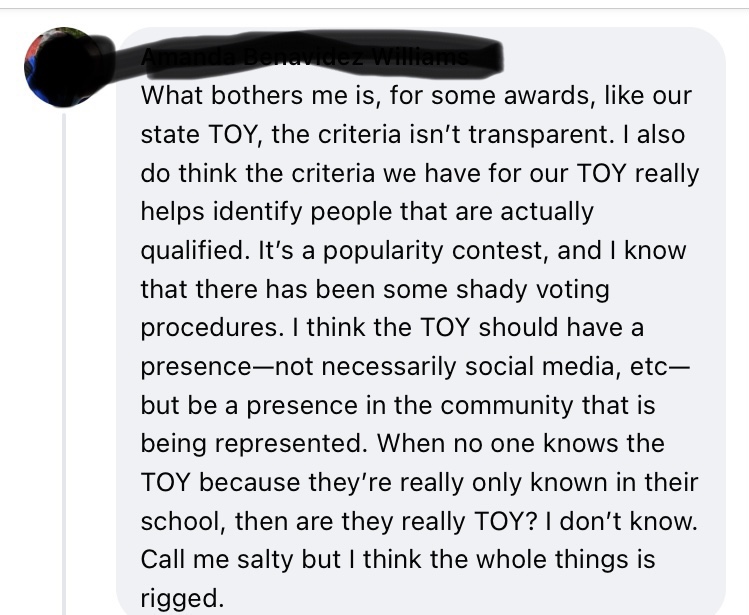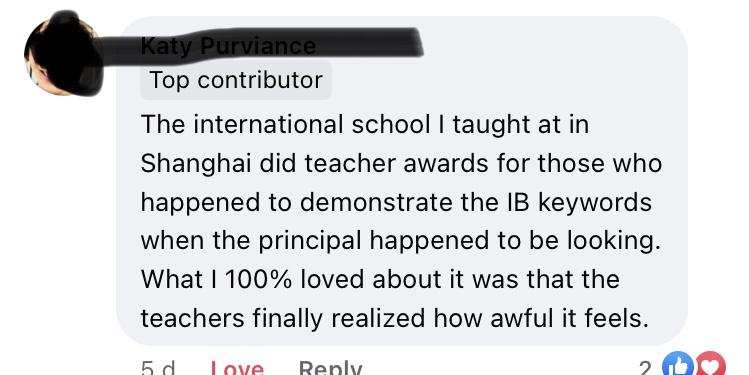
Some years ago, Jen S. and her colleagues built a behaviour rubric for her C.I. classes, which Ben Slavic named JGR and which was discussed on his blog and then elsewhere. Here is a version I have played around with: INTERPERSONAL COMMUNICATION rubric. I initially opposed the use of JGR, then used it, then ditched it, and now I use it (but not for marks). Note: this is a modified version of the original JGR; and I don’t know for how long she used her rubric, or if she still does, or what the original looked like.
JGR was developed because– like all of us, especially me– the creator had some challenges managing her C.I. classes in her initial year with T.P.R.S., which can in (especially my) rookie hands turn into a “woo-hoo no more textbook!” clown show. JGR basically “marks” classroom behaviour. JGR specifies that students make eye contact, add story details, ask for help, not blurt, not use cell-phones etc. Jen used it (and if memory serves Ben also recommended its use) by making part of her class mark a function of behaviour as marked by JGR. So the kids might get, say, 20% of their mark each for reading, writing, listening, speaking and 20% for their in-class behaviour. Part of the thinking here was that some behaviours lead to acquisition, while others do not and also wreck the classroom environment, and so “acquisition-rewarding” behaviour should be rewarded.
JGR– for many people, including me– “works.” Which is why– especially when linked with allegedly “acquisition-promoting” behaviours– lots of people are interested in it.
JGR is a kind of “carrot-and-stick” marking tool: if the kids engaged in the behaviours JGR specified, their marks went up, partly because (a) they got marks for those behaviours, and partly because (b) the behaviours should– in theory– help them acquire more language.
This can of worms was shaken around a bit on Ben’s blog, and recently, thanks to the always-remarkable Terry Waltz, there have been FB and Yahoo discussions about it. So, today’s question:
Should we assess in-class behaviour for final marks purposes?
My answer: no, never. Why?
1. Behaviours typically asked for in JGR– or other such rubrics– are not part of any curricula of which I am aware. Every language curriculum says something like, students of the Blablabian language will read, write, speak and understand spoken Blablabian, and maybe say something about Blablabian culture. Nowhere does any curriculum say “students should suggest details for stories” or “students will lookthe teacher in the eye.”
If it’s going to get a mark, it has to be part of course outcomes. Any assessment guru (Wormelli, Harlen, etc) will tell you the same thing: we do not mark attitude, behaviour, homework, etc, as these are not part of final outcomes.
To put it another way, how do we judge the New England Patriots football team? By how well, often and/or enthusiastically they practice and look Bill Belichick in the eye, or by how many games they win? How should Tom Brady be paid: by how often he shows up for practice, and how nice he is to Belichick, or by how many yards he successfully throws? That’s right.
We could– and I often do– end up in situations where a “bad” kid does well, or a “good” kid does poorly. I have had bright-eyed, bushy-tailed teacher’s pet-type kids who were not especially good at Spanish, and I have had giant pains-in-the-butt who were quite good.
My best-ever student in TPRS, Hamid Hamid, never added story details, never looked up, and always faced away from the board. Yet he CRUSHED on assessments and got 100% in Spanish 2. Two years later, his younger brother, Fahim (also a great student) told me that Hamid Hamid was both shy and deaf in his left ear, so always “pointed” his right ear at the board (and so appeared to be looking away). This kid’s mark would have been lowered by assessing his “in-class behaviour,” which– given his epic Spanish skills– would have been absurd.
2. As Terry Waltz points out, neurodivergent kids can– and do– acquire language without engaging in many behaviours typically required by participation and behaviour rubrics. She also points out that forcing neurodivergent kids into the “normal” mold is at best less than productive. If you are autistic, anxious, suffering from PTSD (as my stepdaughter does) or facing any other neuro challenges, “engagement” rubrics can make your life miserable while not appreciably meaningfully measuring what you can do with the language.
3. The only thing required for language acquisition is reception of comprehensible input. While the focus of behaviour rubrics is designed to get kids to tune in, it does not follow that many behaviours which do make for a good class– e.g. people adding good details to stories, looking at each other– are necessary to acquire language.
All of us have been there: you have a plan, you did your story warmup or whatever, but the kids aren’t into it. You bust out a Movietalk but they aren’t into that either. Dead class. Now, in a C.I. class, we don’t have recourse to worksheets or whatever, and we still have to teach the language. I have a bail-out move here: direct translation, and I always have a novel on the go, so I can read aloud, and Q&A the novel. If I’m being particularly non-compelling, I’ll throw an exit quiz at them.
The point: if the kids are getting C.I., they are acquiring. If they are miserable/tired/bored with stories, fine. They are gonna get C.I. one way or another.
4. Any kind of behaviour rubric plays the awful “rewards” game. Ask yourself this question: why do I teach? The answer– other than because I have to make a living— is probably something like, because it’s interesting, I have some measure of control over my work, and I love kids and my subject. Some will add that teaching, properly done, opens doors for kids. Teachers do not teach because they want to be evaluated, or because they want to use the latest gizmo, or because they want public praise, etc. They are, in other words, intrinsically motivated. They want to work because the work is good and worthy in itself.
When we institute rewards for behaviours, as Alfie Kohn has spent a career arguing, we destroy intrinsic motivation. We turn something interesting into payment for marks. The point stops being paying attention to the story– or adding to it cos you actually care about it– and becomes something rote.
5. Using behaviour rubrics can dampen professional self-examination. If my practice is such that I have to use marks as a stick to keep kids in line (the policing metaphor is not an accident), there are two possibilities: tough kids, and/or I am doing a bad job. The question why are they not tuned in? might be answerable with any of the following:
— I am not being sufficiently comprehensible
— I am ignoring the top or the bottom end of the class– too fast/slow or simple/complex
— my activities are not interesting, varied or meaningful enough
— the kids see no purpose
— accountability: they don’t see tuning in as something that results in real gains
— I lack basic skills (smart circling, control of vocab, etc etc)
— my story sucks 😉
I had better be able to look in the mirror, consider and then deal with these possibilities, rather than merely acting like a cop and demanding obedience.
Now, behaviour does matter. You cannot run a T.P.R.S. class without rules etc. My basic rules:
- no phones or other distractions (including side-talk, blurting etc)
- no insults of anyone other than oneself or of rich entitled people
- listen, watch and read with the intent to understand; ask when you don’t
- do not create or engage in distractions
The tools that we have for dealing with distracting behaviour include
- warning the offender, standing by their desk, calling Mom and Dad, etc
- pointing, with a smile, to classroom rules every time there is a problem
- sending them to admin if necessary
- taking their phone until 3:15 (most kids would rather die)
- detention, where we discuss behaviour
- assigning read & translate (quiet seatwork)
- taking the kids outside for a walk, or doing some other kind of physical brain-break
- changing activities
- doing a quiz
- talking to kids one on one and asking what do I need to do to get you focused?
The upshot? We should not, and need not, mark “behaviour” or “participation.”
Addendum: is there ever a use for classroom behaviour rubrics?
Yes. I get my kids to self-evaluate using JGR every 2-3 weeks. My version generates a mark out of 20.
Nineteen out of twenty kids will very honestly self-evaluate their behaviour, provided they understand exactly what is expected. One kid in twenty will heap false praise on him/herself. For the false praisers (“I never blurt in class!”), I sit them down and explain what I think, then we agree on a more realistic mark.
I save these JGR “marks” and once in a blue moon, when a helicopter parent or an Admin wants to know, how is Baninder doing in Spanish, I can point to both the spreadsheet with Numberz and JGR. This frames the inevitable discussion about marks in terms any parent can understand. Any parent, from any culture, understands that if Johnny screws around and/or does not pay attention in class, his mark will drop.
JGR– in my experience– accurately “predicts” the marks of about 80% of kids. When I can show a kid (or a parent or admin), look, here are Johnny’s marks AND Johnny’s own description of how he behaves in class, we can have an honest discussion about marks, Spanish, etc. Win-win.









